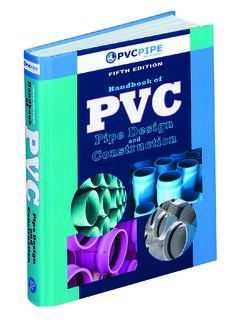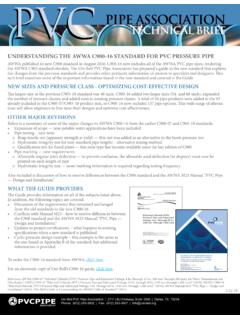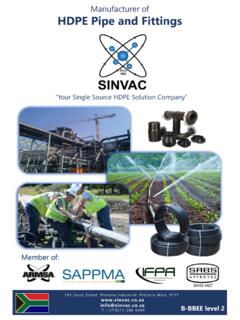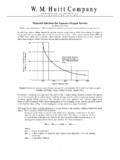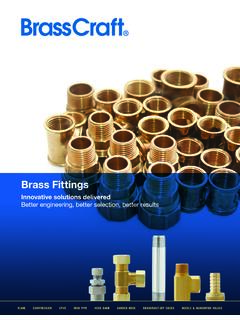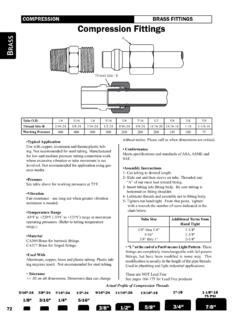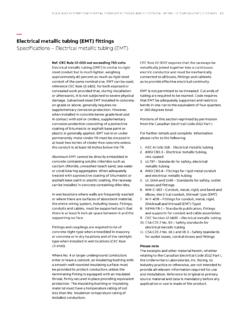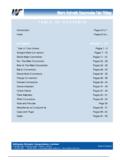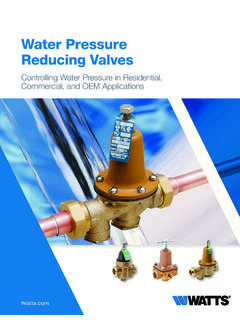Transcription of Guide for PVC Pressure Fittings - Uni-Bell
1 Guide FORPVC Pressure FITTINGSPVC Pressure FITTINGSTABLE OF CONTENTSI ntroduction 3 Standards and Specifications 3 Products 4 Manufacturing Methods 8 Fabricated Fittings 8 Injection-Molded Fittings 9 Machined Couplings 9 Compatibility with Dissimilar Materials 9 Designing to Prevent Pipe Movement 10 Internally Restrained Joints 11 External Restraint Devices 12 Concrete Thrust Blocks 13 Installation 13 Handling 13 Pipe and fitting Preparation 13 Joint Assembly 13 Changes in Direction
2 14 Acceptance Testing 14 Member Company Fittings Manufacturers 152 PVC Pressure FITTINGSINTRODUCTION This document has been developed by the Uni-Bell PVC Pipe Association for design and installation of gasketed PVC Fittings where gasketed PVC Pressure pipe is used in potable water, force main, Pressure irrigation, and reclaimed water applications. The Guide provides information on gasketed PVC Fittings that are available for various dimension ratios and outside diameters of PVC pipe through 60-inch. This document does not include information on solvent welded or fusible PVC AND SPECIFICATIONSP roduct standards used in this Guide include.
3 ASTM D2774, Standard Practice for Underground Installation of Thermoplastic Pressure Piping ASTM D3139, Standard Specification for Joints for Plastic Pressure Pipes Using Flexible Elastomeric Seals ASTM F477, Standard Specification for Elastomeric Seals (Gaskets) for Joining Plastic Pipe ASTM F1674, Test Method for Joint Restraint Products for Use with PVC Pipe AWWA C605, Underground Installation of Polyvinyl Chloride (PVC) and Molecularly Oriented Polyvinyl Chloride (PVCO) Pressure Pipe and Fittings AWWA C900, Polyvinyl Chloride (PVC) Pressure Pipe and Fabricated Fittings , 4-inch through 60-inch (100 mm through 1500 mm)Note: In 2016, AWWA s latest edition of C900 consolidated all diameters 4-inch through 60-inch into a single standard; therefore, all fabricated Fittings and machined couplings can now be specified by referencing the C900 standard.
4 AWWA C907, Injection-Molded Polyvinyl Chloride (PVC) Pressure Fittings , 4-inch through 12-inch (100 mm through 300 mm), for Water, Wastewater, and Reclaimed Water Service CSA , PVC Injection-Moulded Gasketed Fittings for Pressure Applications CSA , Rigid Polyvinyl Chloride (PVC) Pipe for Pressure Applications FM1612, Polyvinyl Chloride (PVC) Pipe and Fittings For Underground Fire Protection Service NSF/ANSI 14, Plastics Piping System Components and Related Materials NSF/ANSI 61, Drinking Water System Components Health Effects UL1285, Standard for Pipe and Couplings, Polyvinyl Chloride (PVC), and Oriented Polyvinyl Chloride (PVCO) for Underground Fire Service Guide FOR PVC Pressure Fittings 3 PVC Pressure FITTINGSPRODUCTSThe different types of Fittings are as follows: Tees have an outstanding leg that is 90 from the have two outstanding legs that are opposite each PVC Pressure FITTINGSPRODUCTS (CONT.)
5 Bends can have standard angles ( , , 45 and 90 ) or any custom-built angle from 1 to 90 .Sweeps are used to change alignment/direction while reducing hydraulic are typically available from 1 to 5 . Guide FOR PVC Pressure Fittings 5 PVC Pressure FITTINGSPRODUCTS (CONT.)Couplings/Sleeves are used to join two pipes that have the same diameter. These have multiple applications including: Tie-in connections to existing lines Connecting short lengths of pipe Repairing damaged pipelines Changing pipeline direction (high-deflection coupling)Reducers/Tapers/Adapters are used to transition between two different pipe PVC Pressure FITTINGSPRODUCTS (CONT.)
6 Tapped Couplings are one-piece Fittings with pre-molded threads for service taps. Tapped couplings are available to accommodate various mainline sizes with numerous tap are designed for stopping flow on a segment of pipe. Plugs are used at dead ends. Guide FOR PVC Pressure Fittings 7 PVC Pressure FITTINGSPRODUCTS (CONT.)MANUFACTURING METHODST here are three manufacturing methods used for AWWA PVC Fittings . All three types use gasketed push-on joints and the internal Pressure capacity is equal to or greater than that of the pipe Pressure rating. FABRICATED Fittings Fabricated Fittings are constructed from sections of PVC pipe meeting the requirements of the AWWA C900 standard.
7 Their constituent parts are the same as the pipeline with which they will be used. The body of the fitting is extruded PVC pipe that has already passed the standard s testing requirements. Fabricated Fittings include single thermoformed bends and couplers. As well, multiple segments of PVC pipe can be cut into wedge shapes, or prepared to accept leg insertions, and joined under factory-controlled conditions to form an essentially homogeneous structure. Reinforcement may be applied and permanently bonded to the outside surfaces of the products include: Tees Crosses Bends (standard or custom angles) Couplings Reducers Adapters TapersCustom Products can be manufactured and are available in push-on or restrained PVC Pressure FITTINGSF abricated PVC Fittings are available for any size PVC pipe from 4-inch through 60-inch.
8 Fabricated Fittings are available in multiple Pressure classes and have the same or greater Pressure class as the PVC pipe to which they are joined. Please use AWWA C900 for fabricated Fittings recommended specifications. INJECTION-MOLDED Fittings Injection-molded Fittings are manufactured by injecting PVC compound into a mold cavity per AWWA C907. The standard requires that each fitting be made from PVC compound with a minimum Hydrostatic Design Basis of 4,000 psi and a short-term strength of 6,400 psi. Qualification tests must produce a long-term Pressure strength of 470 psi. Injection-molded PVC Fittings have a wall thickness a minimum of 25% thicker than DR18 products include: Bends (standard or custom angles) Couplings Tees Reducers Adapters Plugs Tapped couplingsInjection-molded Fittings are available from 4-inch to 12-inch diameters in Pressure Class 235 psi.
9 MACHINED COUPLINGS Machined couplings are constructed from sections of PVC pipe meeting the requirements of the AWWA C900 standard. They are produced from a combination of molding and fabricating methods and available for any size PVC pipe from 4-inch through 60-inch. Please reference AWWA C900 for fabricated Fittings recommended WITH DISSIMILAR MATERIALSP ipes and Fittings made from PVC and Ductile Iron (DI) use the same outside diameter regimen, meaning that the outside diameters specified in both product standards are identical. (Note: CIOD = Cast Iron Outside Diameter, which is the same as cast iron pipe size.) PVC fabricated Fittings and injection-molded Fittings are available in CIOD and Iron Pipe Size (IPS).
10 Guide FOR PVC Pressure Fittings 9 PVC Pressure FITTINGST ransitioning from a PVC pipe or fitting into a DI pipe or fitting is easily accomplished when inserting PVC spigots into iron bells. In this situation, a coupling is not necessary. If making this transition requires a DI spigot into a PVC bell, transition couplings are necessary. Check with a manufacturer if connecting to other diameter regimens. NOTE: Never insert a DI spigot into a PVC bell. This is because DI pipe outside diameters are held to tight tolerances in the inside of the bell and the outside of the spigot, while the outside of the remainder of the barrel of the pipe is held to looser tolerances.




